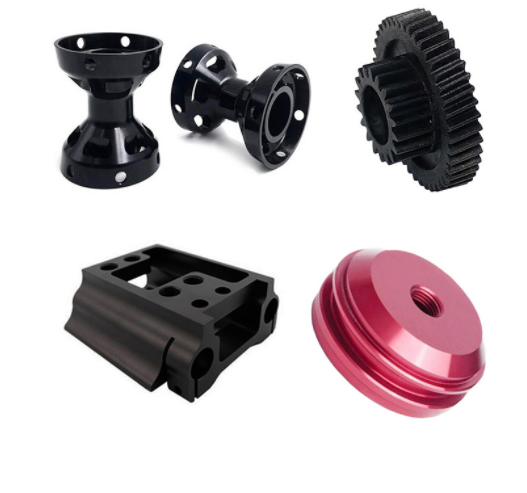CNC Turning Service
CNC Turning Service
This service is perfect for both prototypes and production runs, delivering fast turnaround times and cost-effective solutions. Whether you need small or large quantities, our skilled machinists and state-of-the-art equipment ensure the highest quality results for your CNC turned parts.
Our CNC Turning Service offers high-precision, efficient machining for cylindrical parts and components. Using advanced CNC turning technology, we can create parts with tight tolerances and smooth finishes from a variety of materials, including metals, plastics, and composites. CNC turning is ideal for producing round or tubular shapes, such as shafts, pins, and bushings, with exceptional accuracy and consistency.
CNC Materials
Materials Available at Avinyaworks
| Material | Available Varieties |
|---|---|
Aluminum | Aluminum 5052, |
Brass/Bronze | Brass C360, |
Copper | EPT Copper C110, |
Plastics | ABS, |
Steel | Alloy Steel 4130, |
Titanium | Titanium Grade 2, |
Zinc | Zinc Sheet Alloy 500 |
Available Finishes
As-Milled
This finish option offers the quickest turnaround time. Parts will have visible tool marks and may feature sharp edges or burrs, which can be removed upon request. The surface finish is comparable to a 125 µin Ra finish.
Bead Blast
Anodized (Type II or Type III)
Type II anodizing creates a corrosion-resistant finish and is commonly used with aluminum. Parts can be anodized in various colors, with clear, black, red, and gold being the most popular options. Type III anodizing is thicker, providing both enhanced wear resistance and the corrosion protection offered by Type II.
Powder Coat
Powder coating involves spraying powdered paint onto a part, which is then baked in an oven to form a strong, durable layer. This process results in a wear- and corrosion-resistant finish that outperforms traditional painting methods. A wide range of colors is available to achieve the desired aesthetic.
Applications of CNC Turning
Advantages of CNC Milling
High Precision and Accuracy
CNC turning offers exceptional precision, enabling the production of parts with tight tolerances and smooth finishes, essential for high-quality components.
Complex Geometries
CNC turning can produce complex, symmetrical shapes, such as shafts, threads, and tapered parts, that would be difficult or time-consuming to create with traditional methods.
Minimal Material Waste
As a subtractive process, CNC turning only removes the material required for the final part, reducing waste compared to other manufacturing methods.
Automation and Consistency
With CNC turning, the process is automated, leading to consistent, repeatable results with minimal human intervention, reducing the risk of errors.
Wide Material Compatibility
CNC turning can work with a broad range of materials, including metals (such as steel, aluminum, and titanium) and plastics (like acetal and ABS), making it highly versatile for different applications.
Cost-Effective for Small and Large Runs
CNC turning is ideal for both low- and high-volume production runs, making it a cost-effective solution for producing small batches or large quantities of parts.
Flexibility for Design Changes
CNC turning machines are easily reprogrammable, allowing for quick adjustments to designs and ensuring flexibility for iterative development or last-minute changes.
CNC General Tolerances
| Description | General Tolerance |
|---|---|
|
Distance Dimensions |
For features of size (Length, width, height, diameter) and location (position, concentricity, symmetry) +/- 0.005”. |
|
Orientation and Form Dimensions |
0-12″ +/- 0.005″, Angularity 1/2 degree. For 24″ and beyond please consult us Manufacturing Standards. |
|
Edge Condition |
Sharp edges will be broken and deburred by default. Critical edges that must be left sharp should be noted and specified on a print. |
Overview: What is CNC Turning?
CNC turning is a machining process that uses a computer-controlled lathe to shape cylindrical parts by rotating the workpiece against cutting tools. The cutting tools, typically a combination of drills, lathes, and mills, are used to remove material from the rotating workpiece, creating parts with precise dimensions and smooth finishes.
The process is guided by a CAD (Computer-Aided Design) file, which translates the design into a set of instructions for the CNC machine. CNC turning can produce parts with a variety of geometries, including round, tapered, and cylindrical shapes, as well as features like threads and grooves.

Benefits Of CNC Mill Machining Processes
High Precision and Accuracy: CNC turning provides excellent accuracy with tight tolerances, ensuring that parts meet the required specifications and have smooth, high-quality finishes.
Speed and Efficiency: CNC turning machines operate quickly and efficiently, reducing cycle times and enabling fast production for both prototypes and high-volume production runs.
Versatility in Material Options: CNC turning can handle a wide range of materials, including metals like aluminum, steel, titanium, and plastics such as acetal and ABS, making it suitable for a variety of applications.
Complex Geometries: CNC turning is capable of producing complex cylindrical shapes, such as threads, tapered features, and grooves, that would be difficult or time-consuming to create with manual methods.
Minimal Waste: As a subtractive process, CNC turning only removes the material needed for the final part, reducing material waste compared to other manufacturing methods.

Why Choose Avinyaworks For CNC Turning Service?
Endless Options
Choose from a vast array of material options, finishes, tolerances, markings, and certifications to customize your order to meet your exact specifications.
Easy to Use
Receive your parts delivered directly to your door, eliminating the hassle of sourcing, project management, logistics, and shipping.
High Quality
Receive high-quality parts delivered directly to your door, eliminating the hassle of sourcing.

